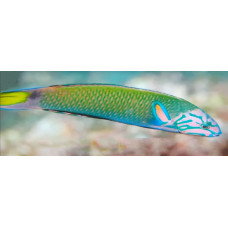Latin name
Thalassoma lunare
Other names
Crescent wrasse, lyretail wrasse.
Identification
They lead a diurnal lifestyle, they have excellent eyesight, they also have a pretty good sense of smell.
Features of fish fins
Dorsal spines (total): 8; Dorsal soft rays (total): 13; Anal spines: 3; Anal soft rays: 11.
Fish colouring
The lower half of the body of juveniles is blue, with a black spot in the middle of the dorsal fin and a black spot at the base of the caudal fin. As they mature, this spot turns into a yellow crescent, hence the name. The body is green, with pronounced scales. The coloration of the head varies from blue to purple, with a broken checkerboard pattern.
Distribution
Indo-Pacific: Red Sea and East Africa to the Line Islands, north to southern Japan, south to Lord Howe Island and northern New Zealand.
Habitat
A subtropical marine species. It is an inhabitant of coral reefs and adjacent areas at depths of 1 to 20 m (3.3 to 65.6 ft).
Size
The total length of this species can reach 18 inches (45 cm).
Behavior
Active fish that are on the move throughout the day. They are also territorial and will pinch, chase, and otherwise disturb fish that get in their way. At night they rest in niches, often under rocks or similar structures. If necessary, they will dig a place under a rock.
Food and feeding habits
They are carnivorous and usually feed on fish eggs and small invertebrates on the sea floor.
Reproduction
Are primordial hermaphrodites, all of which start out as females and develop into males, a process that takes only 10 days. Some individuals live in groups consisting of a dominant male and a "harem" of about a dozen other wrasses, including females and males. The alpha male is more colorful and at every hour of low tide changes color from green to blue and puts on a show by attacking and biting all the other wrasses. During the breeding season and before high tide, the alpha male turns completely blue and picks off every single female and the spawning frenzy begins.
Fishing
The fish are not important to the local commercial fishery.
Relationship with a person
They can live up to ten years in captivity, although this period is shorter in the wild. They are popular in aquariums because of their hardy nature, brilliant coloration, and attractive behavior.
| Classification | |
| Phylum | Chordata |
| Class | Actinopterygii |
| Squad | Labriformes |
| Family | Labridae |
| Genus | Thalassoma |
| Species | T. lunare |
| Features | |
| Conservation status | Least Concern |
| Habitat | Pelagic |
| Life span, years | 10 |
| Maximum body weight, kg | No information |
| Maximum length, cm | 45 |
| Sailing speed, m/s | No information |
| Threat to people | Edible |
| Way of eating | Predator |
Moon wrasse
Tags: moon wrasse



